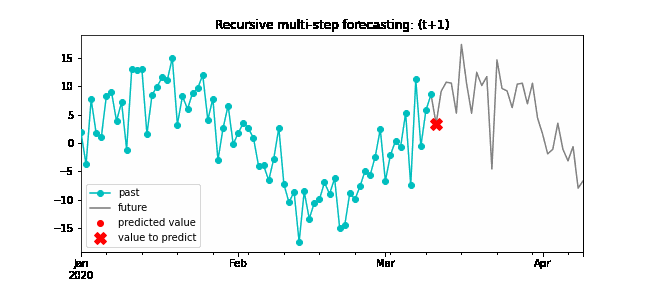Recursive multi-step forecasting¶
Since the value of $t_{n-1}$ is required to predict $t_{n}$, and $t_{n-1}$ is unknown, a recursive process is applied in which, each new prediction, is based on the previous one. This process is known as recursive forecasting or recursive multi-step forecasting.

The major challenge when using machine learning models for recursive multi-step forecasting is transforming the time series into a matrix where each value of the series is related to the time window (lags) that precedes it. This forecasting strategy can be easily generated with the classes ForecasterAutoreg and ForecasterAutoregCustom.

Libraries¶
# Libraries
# ==============================================================================
import pandas as pd
import matplotlib.pyplot as plt
from skforecast.ForecasterAutoreg import ForecasterAutoreg
from sklearn.ensemble import RandomForestRegressor
from sklearn.metrics import mean_squared_error
Data¶
# Download data
# ==============================================================================
url = ('https://raw.githubusercontent.com/JoaquinAmatRodrigo/skforecast/master/data/h2o.csv')
data = pd.read_csv(url, sep=',', header=0, names=['y', 'datetime'])
# Data preprocessing
# ==============================================================================
data['datetime'] = pd.to_datetime(data['datetime'], format='%Y/%m/%d')
data = data.set_index('datetime')
data = data.asfreq('MS')
data = data['y']
data = data.sort_index()
# Split train-test
# ==============================================================================
steps = 36
data_train = data[:-steps]
data_test = data[-steps:]
# Plot
# ==============================================================================
fig, ax=plt.subplots(figsize=(9, 4))
data_train.plot(ax=ax, label='train')
data_test.plot(ax=ax, label='test')
ax.legend();
Train forecaster¶
# Create and fit forecaster
# ==============================================================================
forecaster = ForecasterAutoreg(
regressor = RandomForestRegressor(random_state=123),
lags = 15
)
forecaster.fit(y=data_train)
forecaster
=================
ForecasterAutoreg
=================
Regressor: RandomForestRegressor(random_state=123)
Lags: [ 1 2 3 4 5 6 7 8 9 10 11 12 13 14 15]
Transformer for y: None
Transformer for exog: None
Window size: 15
Included exogenous: False
Type of exogenous variable: None
Exogenous variables names: None
Training range: [Timestamp('1991-07-01 00:00:00'), Timestamp('2005-06-01 00:00:00')]
Training index type: DatetimeIndex
Training index frequency: MS
Regressor parameters: {'bootstrap': True, 'ccp_alpha': 0.0, 'criterion': 'squared_error', 'max_depth': None, 'max_features': 1.0, 'max_leaf_nodes': None, 'max_samples': None, 'min_impurity_decrease': 0.0, 'min_samples_leaf': 1, 'min_samples_split': 2, 'min_weight_fraction_leaf': 0.0, 'n_estimators': 100, 'n_jobs': None, 'oob_score': False, 'random_state': 123, 'verbose': 0, 'warm_start': False}
Creation date: 2022-09-24 08:20:30
Last fit date: 2022-09-24 08:20:30
Skforecast version: 0.5.0
Python version: 3.9.13
Prediction¶
# Predict
# ==============================================================================
predictions = forecaster.predict(steps=36)
predictions.head(3)
2005-07-01 0.921840 2005-08-01 0.954921 2005-09-01 1.101716 Freq: MS, Name: pred, dtype: float64
# Plot predictions
# ==============================================================================
fig, ax=plt.subplots(figsize=(9, 4))
data_train.plot(ax=ax, label='train')
data_test.plot(ax=ax, label='test')
predictions.plot(ax=ax, label='predictions')
ax.legend();
# Prediction error
# ==============================================================================
error_mse = mean_squared_error(
y_true = data_test,
y_pred = predictions
)
print(f"Test error (mse): {error_mse}")
Test error (mse): 0.00429855684785846
Prediction intervals¶
A prediction interval defines the interval within which the true value of y is expected to be found with a given probability. For example, the prediction interval (1, 99) can be expected to contain the true prediction value with 98% probability.
By default, every ForecasterAutoreg and ForecasterAutoregCustom can estimate prediction intervals using the method predict_interval. For a detailed explanation of the different prediction intervals available in skforecast visit Prediction intervals.
# Predict intervals
# ==============================================================================
predictions = forecaster.predict_interval(steps=36, interval=[5, 95], n_boot=100)
predictions.head(3)
| pred | lower_bound | upper_bound | |
|---|---|---|---|
| 2005-07-01 | 0.921840 | 0.884362 | 0.960898 |
| 2005-08-01 | 0.954921 | 0.923163 | 0.980901 |
| 2005-09-01 | 1.101716 | 1.057791 | 1.143083 |
Feature importance¶
forecaster.get_feature_importance()
| feature | importance | |
|---|---|---|
| 0 | lag_1 | 0.012340 |
| 1 | lag_2 | 0.085160 |
| 2 | lag_3 | 0.013407 |
| 3 | lag_4 | 0.004374 |
| 4 | lag_5 | 0.003188 |
| 5 | lag_6 | 0.003436 |
| 6 | lag_7 | 0.003136 |
| 7 | lag_8 | 0.007141 |
| 8 | lag_9 | 0.007831 |
| 9 | lag_10 | 0.012751 |
| 10 | lag_11 | 0.009019 |
| 11 | lag_12 | 0.807098 |
| 12 | lag_13 | 0.004811 |
| 13 | lag_14 | 0.016328 |
| 14 | lag_15 | 0.009979 |
Extract training matrix¶
X, y = forecaster.create_train_X_y(data_train)
X.head()
| lag_1 | lag_2 | lag_3 | lag_4 | lag_5 | lag_6 | lag_7 | lag_8 | lag_9 | lag_10 | lag_11 | lag_12 | lag_13 | lag_14 | lag_15 | |
|---|---|---|---|---|---|---|---|---|---|---|---|---|---|---|---|
| datetime | |||||||||||||||
| 1992-10-01 | 0.534761 | 0.475463 | 0.483389 | 0.410534 | 0.361801 | 0.379808 | 0.351348 | 0.336220 | 0.660119 | 0.602652 | 0.502369 | 0.492543 | 0.432159 | 0.400906 | 0.429795 |
| 1992-11-01 | 0.568606 | 0.534761 | 0.475463 | 0.483389 | 0.410534 | 0.361801 | 0.379808 | 0.351348 | 0.336220 | 0.660119 | 0.602652 | 0.502369 | 0.492543 | 0.432159 | 0.400906 |
| 1992-12-01 | 0.595223 | 0.568606 | 0.534761 | 0.475463 | 0.483389 | 0.410534 | 0.361801 | 0.379808 | 0.351348 | 0.336220 | 0.660119 | 0.602652 | 0.502369 | 0.492543 | 0.432159 |
| 1993-01-01 | 0.771258 | 0.595223 | 0.568606 | 0.534761 | 0.475463 | 0.483389 | 0.410534 | 0.361801 | 0.379808 | 0.351348 | 0.336220 | 0.660119 | 0.602652 | 0.502369 | 0.492543 |
| 1993-02-01 | 0.751503 | 0.771258 | 0.595223 | 0.568606 | 0.534761 | 0.475463 | 0.483389 | 0.410534 | 0.361801 | 0.379808 | 0.351348 | 0.336220 | 0.660119 | 0.602652 | 0.502369 |
y.head()
datetime 1992-10-01 0.568606 1992-11-01 0.595223 1992-12-01 0.771258 1993-01-01 0.751503 1993-02-01 0.387554 Freq: MS, Name: y, dtype: float64
%%html
<style>
.jupyter-wrapper .jp-CodeCell .jp-Cell-inputWrapper .jp-InputPrompt {display: none;}
</style>